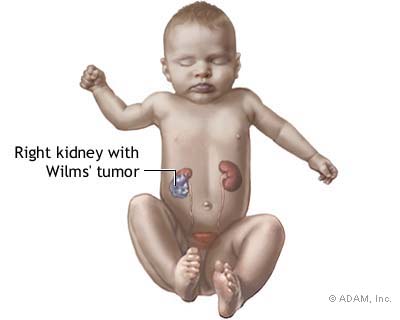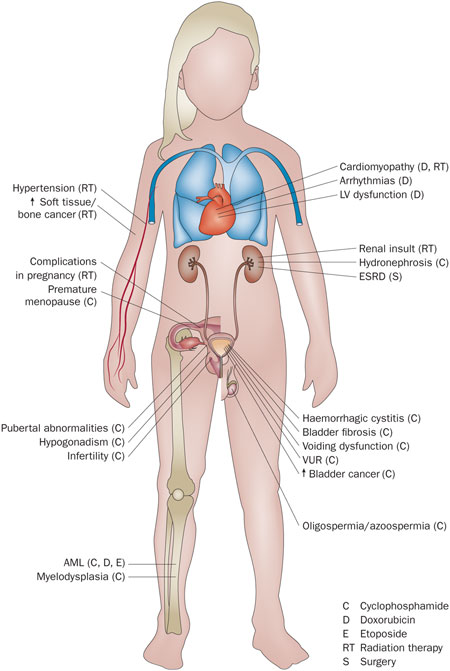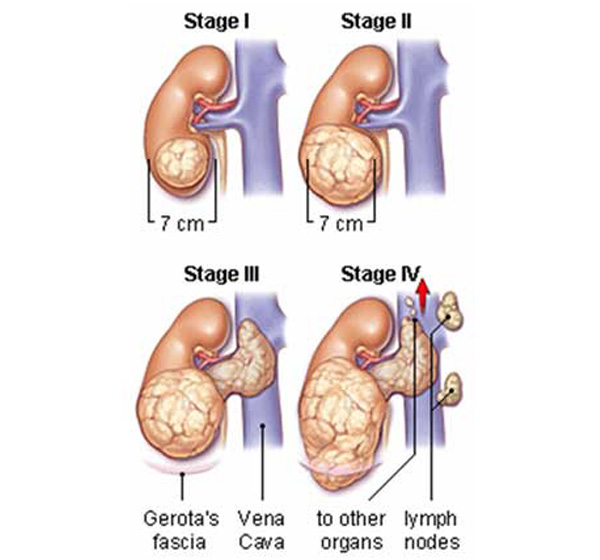Wilms Tumor
Original Editors - Students from Bellarmine University's Pathophysiology of Complex Patient Problems project.
Top Contributors - Rachel Flaherty and Allison Hafele
Definition/Description[edit | edit source]
Wilms’ Tumor, also known as nephroblastoma, is a solid tumor of the kidney that develops from immature kidney cells.Cite error: Invalid <ref> tag; name cannot be a simple integer. Use a descriptive title It is the most common cancer of the kidneys in children, and the fourth most common type of cancer in children.Cite error: Invalid <ref> tag; name cannot be a simple integer. Use a descriptive titleCite error: Invalid <ref> tag; name cannot be a simple integer. Use a descriptive title Wilms’ tumors are most often unilateral, affecting only one kidney.Cite error: Invalid <ref> tag; name cannot be a simple integer. Use a descriptive title 5-10% of children with Wilms’ tumors have more than one tumor in the same kidney, and approximately 5% of children with the cancer have bilateral Wilms’ tumors, affecting both kidneys.Cite error: Invalid <ref> tag; name cannot be a simple integer. Use a descriptive title
www.cancer.org/acs/groups/cid/documents/webcontent/003149-pdf.pdf
Prevalence[edit | edit source]
Wilms’ tumor is most common in children ages 3 to 4 and becomes much less common after the age of 5.Cite error: Invalid <ref> tag; name cannot be a simple integer. Use a descriptive title Wilms’ tumor affects boys are girls equally, and can also be found in adults, though it is very rare.Cite error: Invalid <ref> tag; name cannot be a simple integer. Use a descriptive title On average, there are 460 new cases of Wilms’ tumor diagnosed in the United States every year. Approximately 1 in 8,000-10,000 children are affected.Cite error: Invalid <ref> tag; name cannot be a simple integer. Use a descriptive title About 5% of all cancers in children are Wilms’ tumors.Cite error: Invalid <ref> tag; name cannot be a simple integer. Use a descriptive title
Characteristics/Clinical Presentation[edit | edit source]
Wilms’ tumor is often hard to find early because the tumor can grow large without any signs or symptoms. These children may look and act normally.Cite error: Invalid <ref> tag; name cannot be a simple integer. Use a descriptive title The most common first clinical sign is swelling or a hard mass in the abdomen. It is often firm and large enough to be palpated on both sides of the abdomen, and is usually not painful.Cite error: Invalid <ref> tag; name cannot be a simple integer. Use a descriptive title
Some children may also experience:Cite error: Invalid <ref> tag; name cannot be a simple integer. Use a descriptive titleCite error: Invalid <ref> tag; name cannot be a simple integer. Use a descriptive title
- Fever
- Loss of appetite
- Shortness of breath
- Constipation
- Nausea
- Blood in the urine
- Abdominal pain
Wilms’ tumors may also cause high blood pressure. The blood pressure can get high enough to cause bleeding in the eye or a change in consciousness in rare cases.Cite error: Invalid <ref> tag; name cannot be a simple integer. Use a descriptive title
Associated Co-morbidities[edit | edit source]
The types of secondary cancers include bone and soft tissue sarcomas, breast cancer, lymphoma, tumors of the digestive tract, melanoma and acute leukaemias. Certain birth defects and also correlated with Wilms tumor including Aniridia, hemihypertrophy, cryptorchidism, hypospadias.Cite error: Invalid <ref> tag; name cannot be a simple integer. Use a descriptive title There are also several syndromes that are often associated with Wilms tumor including Sotos syndrome, Perlman syndrome, Simpson-Golabi-Behmel syndrome, Bloom syndrome, Frasier syndrome, Beckwith-Wiedemann Syndrome, Denys -Drash syndrome, and WAGR syndrome which are explained in further detail in differential diagnosis. Cite error: Invalid <ref> tag; name cannot be a simple integer. Use a descriptive title
Medications[edit | edit source]
The most effective chemotherapeutics in treatment of nephroblastoma are: actinomycin D (ACT), vincristine (VCR), doxorubicin (ADM), cyclophosphamide (ctx), ifosfamide (IFO), etoposide and carboplatin. (huszno) NWTS recommends polchemotherapy treatment (ACT, VCR, ADM) for a period of 15 weeks in stage III Less aggressive treatment using two medications (VCR and ACT) can be used in cancer stages I and II. (HUZON). It is important to note toxicity of such treatment is highger in adults than in children (HUS).
Toxicity: among vinicristine, dactinomycin and Adriamycin, the main acue toxicity was neuropathy due to vincristine. During chemotherapy with ICE (ifosfamide, carboplatin, etoposide) all patients had hematological toxicity such as neutropenia and thrombocytopenia in stage IV toxicity. The type, timing, and dosage of chemotherapy have been major risk factors in combined therapy. (HU)
Side Effects: Late side effects include cardiotoxicity, reproductive problems, renal dysfunction and the development of benign and malignant second tumors. (HUS) In some cases fertility may be impaired. (HUS) Other side effects of chemotherapy include: hair loss , mouth sores , loss of appetite , nausea and vomiting , diarrhea or constipation , increased chance of infections (from having too few white blood cells), Easy bruising or bleeding (from having too few blood platelets), Fatigue or extreme tiredness (from having too few red blood cells) Cite error: Invalid <ref> tag; name cannot be a simple integer. Use a descriptive title
Below are treatment protocols for the National Wilms' Tumor Study Group (NWTSG) and Society of Pediatric Oncology ( SIOP): (Huszno)
Diagnostic Tests/Lab Tests/Lab Values[edit | edit source]
Physical Examination: Usually first symptoms in adults include pain and haematuria, while children experience palpation detectable, painless, rapidly increasing size, abdominal mass.Cite error: Invalid <ref> tag; name cannot be a simple integer. Use a descriptive title Blood and Urine Tests: A urinalysis may also be performed to look for blood and other substances like catecholamines to rule out adrenal issues (Zhang). Wilms tumor can not be diagnosed by a blood or urine test, but it can provide an overall assessment of health.Cite error: Invalid <ref> tag; name cannot be a simple integer. Use a descriptive title
Imaging Tests: This may include ultrasound, Magentic resonance imaging (MRI), and Computerized tomogrpahy (CT) scan. Cite error: Invalid <ref> tag; name cannot be a simple integer. Use a descriptive title
There are several stages in Wilms' Tumor which help to determine treatment protocols mentioned above in medications. Stage I. The cancer is found only in one kidney, and generally can be completely removed with surgery.
Stage II. The cancer has spread to the tissues and structures near the affected kidney, such as fat or blood vessels, but it can still be completely removed by surgery.
Stage III. The cancer has spread beyond the kidney area to nearby lymph nodes or other structures within the abdomen, and it may not be completely removed by surgery.
Stage IV. The cancer has spread to distant structures, such as the lungs, liver, bones or brain.
Stage V. Cancer cells are found in both kidneys. Cite error: Invalid <ref> tag; name cannot be a simple integer. Use a descriptive title
Other Lab values: A small percentage of Wilms tumors are caused by changes in the WT1 and WT2 genes, which are tumor suppressor genes on chromosome 11. Pathological diagnosis of adult nephroblastoma is based on criteria including: the presence of primitive blastemic spindle or round cell component; abortive or embryonal tubules or glomerular structures. Cytokeratin, vimentin,desmin,actin, and WTI allows to distinguish between other rare cancer types. An elevated serum IL-6 level has already been demonstrated to correlate with poor survival and unfavorable clinical outcome in some solid tissue cancers. (ZHANG). Recently research has shown that B7-H1 expression to be a favorable histology characteristic for Wilms tumor and it is associated with an increased risk of failure of initial therapy. (Reference)
Etiology/Causes[edit | edit source]
Wilms’ tumor is typically seen in otherwise healthy children, and the exact cause in most children is unknown.Cite error: Invalid <ref> tag; name cannot be a simple integer. Use a descriptive titleCite error: Invalid <ref> tag; name cannot be a simple integer. Use a descriptive title However, approximately 10% of patients with the tumor have a congenital anomaly, including certain birth defect syndromes and genetic changes.Cite error: Invalid <ref> tag; name cannot be a simple integer. Use a descriptive title Wilms’ tumor, whether hereditary or sporadic, shows evidence of changes in one or more of at least ten different genes.Cite error: Invalid <ref> tag; name cannot be a simple integer. Use a descriptive title
Kidneys are developed early in fetal growth. Gene mutations in early kidney cells may lead to undeveloped mature kidney cells. These early kidney cells may remain after birth. If the cells do not mature, they may grow out of proportion, forming a Wilms’ tumor. Genes WT1 and WT2 on chromosome 11 are tumor suppressor genes, and mutations of these cause a small number of Wilms’ tumors.Cite error: Invalid <ref> tag; name cannot be a simple integer. Use a descriptive title
Common syndromes that are associated with Wilms’ tumor include the following:
WAGR Syndrome: WAGR stands for Wilms tumor, Aniridia (lack of the iris of the eyes), Genitourinary tract abnormalities, and mental retardation. Children who have WAGR syndrome have approximately 30-50% chance of developing a Wilms’ tumor, and often have them bilaterally. In this syndrome, cells are missing part of chromosome 11, which involves the WT1 gene.Cite error: Invalid <ref> tag; name cannot be a simple integer. Use a descriptive titleCite error: Invalid <ref> tag; name cannot be a simple integer. Use a descriptive title
Beckwith-Wiedemann sydrome: These children are at a 5% risk of having a Wilms’ tumor. This syndrome is caused by a malformation of chromosome 11.Cite error: Invalid <ref> tag; name cannot be a simple integer. Use a descriptive title
Denys-Drash Syndrome: This syndrome is also caused by mutations to the WT1 gene. The risk for Wilms’ tumor in these patients is greater than 90%.Cite error: Invalid <ref> tag; name cannot be a simple integer. Use a descriptive title In this disease, the kidneys become diseased and no longer function at a very young age, leading to a Wilms’ tumor.Cite error: Invalid <ref> tag; name cannot be a simple integer. Use a descriptive title
Less common syndromes linked to Wilms’ tumor:Cite error: Invalid <ref> tag; name cannot be a simple integer. Use a descriptive titleCite error: Invalid <ref> tag; name cannot be a simple integer. Use a descriptive title
- Perlman sydrome
- Sotos syndrome
- Simpson-Golabi-Behmel Syndrome
- Bloom syndrome
- Li-Fraumeni Syndrome
- Frasier Syndrome
- Trisomy 18
- Alagille syndrome
Systemic Involvement[edit | edit source]
Wilms’ tumors often grow to a large size before any symptom manifestation. However, most Wilms’ tumors do not metastasize, despite their large size.Cite error: Invalid <ref> tag; name cannot be a simple integer. Use a descriptive title Hematuria occurs in approximately 30% of cases, and about 25% of children with the tumor will have hypertension.Cite error: Invalid <ref> tag; name cannot be a simple integer. Use a descriptive title
As with all cancer treatment, there may be systemic side effects from chemotherapy and radiation. These may affect the heart, lungs, fertility, skin reactions, and may increase the risk for a second cancer.Cite error: Invalid <ref> tag; name cannot be a simple integer. Use a descriptive title
Medical Management (current best evidence)[edit | edit source]
Management of Wilms’ tumor involves surgery, chemotherapy, and radiation therapy. Most children will receive more than one type of treatment. Treatment is based on both the stage and histology of the Wilms’ tumor.Cite error: Invalid <ref> tag; name cannot be a simple integer. Use a descriptive title
Surgery: The goal of surgery is to remove the tumor in one unit to prevent the spread of cancer cells into the abdomen.Cite error: Invalid <ref> tag; name cannot be a simple integer. Use a descriptive title There are several types of nephrectomy that can be performed:
- Simple Nephrectomy: The entire kidney is removed, and the remaining kidney can increase its capacity and filter all of the blood.Cite error: Invalid
<ref>tag; name cannot be a simple integer. Use a descriptive title - Partial Nephrectomy: This surgery includes resection of the tumor and a section of the kidney tissue surrounding it. Partial nephrectomy is common when the other kidney is damaged or removed.Cite error: Invalid
<ref>tag; name cannot be a simple integer. Use a descriptive title - Radical Nephrectomy: The kidney and surrounding tissues of adrenal gland and ureter are removed.Cite error: Invalid
<ref>tag; name cannot be a simple integer. Use a descriptive title
Chemotherapy: Most children diagnosed with a Wilms’ tumor will receive chemotherapy as one of their treatments. Powerful anti-cancer drugs are typically injected via vein, and the blood carries the drug throughout the entire system.8 Chemotherapy is typically used after the tumor has been surgically removed.Cite error: Invalid <ref> tag; name cannot be a simple integer. Use a descriptive title
Radiation Therapy: This treatment utilizes x-rays and other high-energy rays to destroy cancer cells and shrink the tumor size.Cite error: Invalid <ref> tag; name cannot be a simple integer. Use a descriptive title
The type of treatment received is determined by the stage of the cancer, the type of cell, and the general health of the patient.Cite error: Invalid <ref> tag; name cannot be a simple integer. Use a descriptive title
- Stage I or II: The cancer is limited to the kidney or surrounding structures. Typically the kidney will be removed, as well as tissues and lymph nodes surrounding it. This will be followed with chemotherapy, and some stage II may need radiation.
- Stage III or IV: The cancer has spread outside of the kidney and cannot be removed with surgery. Radiation, along with surgery and chemotherapy will most likely take place.
- Stage V: Wilms’ tumors in bilateral kidneys. Chemotherapy is typically given first to shrink the tumor initially, followed by surgery and radiation.
Physical Therapy Management (current best evidence)[edit | edit source]
There are several long-term side effects of chemotherapy. Childhood cancers tend to respond better to chemotherapy than adult cancers. Children’s bodies also tend to tolerate it better than adults do. Patients do not undergo physical therapy to a large extent but it is a field of healthcare that should be stressed to patients and family members to increase overall strength and decrease fatiguability. Cite error: Invalid <ref> tag; name cannot be a simple integer. Use a descriptive title
Alternative/Holistic Management (current best evidence)[edit | edit source]
Complementary medicine is treatment used in combination with regular medical care. Alternative treatments are used instead of the traditional medical treatment. Although there is not any alternative medicine instead of surgery, radiation or chemotherapy, there are complementary treatments including art therapy or play therapy to reduce stress, peppermint tea to relieve nausea and acupuncture to help relieve pain. Cite error: Invalid <ref> tag; name cannot be a simple integer. Use a descriptive title
Differential Diagnosis[edit | edit source]
There is a strong link between Wilms tumors and certain kinds of birth defects. Infact, 1 in 10 children with Wilms tumor have birth defects Cite error: Invalid <ref> tag; name cannot be a simple integer. Use a descriptive title
WAGR syndrome:
WAGR stands for Wilms tumor, Aniridia, Genitourinary tract abnormalities, and Mental Retardation. Children with this syndrome have about a 30-50% of having a wilms tumor. With this syndrome part of chromosome 11 is missing. Children with this syndrome tned to get Wilms tumor earlier and they are often bilateral. Cite error: Invalid <ref> tag; name cannot be a simple integer. Use a descriptive title
Denys- Drash Syndrome
This is a rare syndrome linked to genetic mutation in WT1 gene. The kidneys become diseased and stop working in which most children will then develop Wilms tumors if the kidneys are not removed. Cite error: Invalid <ref> tag; name cannot be a simple integer. Use a descriptive title
Beckwith-Wiedemann Syndrome:
These children are often of a larger size for their age. This includes organs and is also caused by a defect in chromosome 11. There is a 5% chance of having a Wilms tumor. Cite error: Invalid <ref> tag; name cannot be a simple integer. Use a descriptive title
Other syndromes Wilms tumor have been linked to include:
-Sotos syndrome
-Perlman syndrome
-Simpson-Golabi-Behmel syndrome
-Bloom syndrome
-Frasier syndrome
- Li- Fraumeni syndrome
-Trisomy 18 Cite error: Invalid <ref> tag; name cannot be a simple integer. Use a descriptive title
Case Reports/ Case Studies[edit | edit source]
add links to case studies here (case studies should be added on new pages using the case study template)
Routh J, Grundy P, Anderson J, Retik A, Kurek K. B7-h1 as a biomarker for therapy failure in patients with favorable histology Wilms tumor. The Journal Of Urology [serial online]. April 2013;189(4):1487-1492. Available from: MEDLINE, Ipswich, MA. Accessed March 24, 2014.
Resources
[edit | edit source]
Recent Related Research (from <a href="http://www.ncbi.nlm.nih.gov/pubmed/">Pubmed</a>)[edit | edit source]
see tutorial on <a href="Adding PubMed Feed">Adding PubMed Feed</a>
addfeedhere|charset=UTF-8|short|max=10
== References == Huszno J, Starzyczny-Slota D, Jaworska M, Nowara E. Adult Wilms’ tumor-diagnsis and current therapy. Cent Eur J Urol. 2013. http://www.ncbi.nlm.nih.gov/pmc/articles/PMC3921847/pdf/CEJU-66-00262.pdf. Accessed March 2, 2014. American Cancer Society: Wilms Tumor. 2013. Accessed March 2, 2014. http://www.cancer.org/acs/groups/cid/documents/webcontent/003149-pdf.pdf










